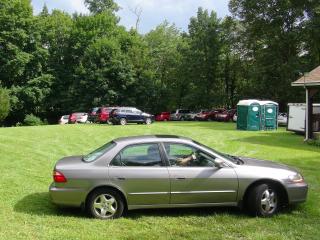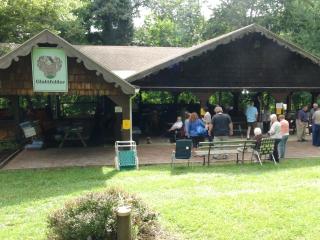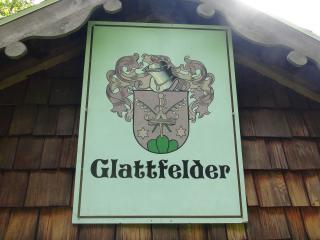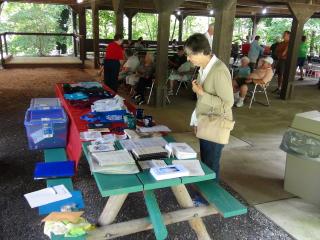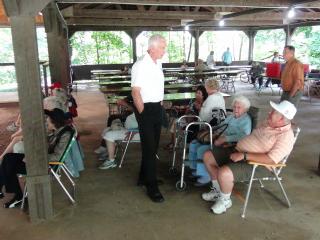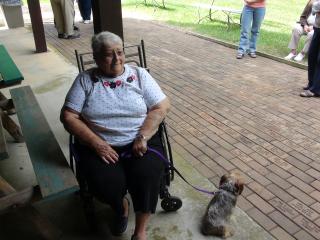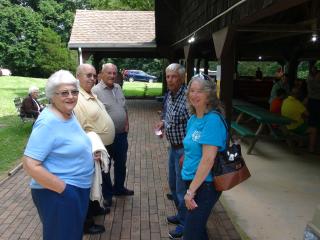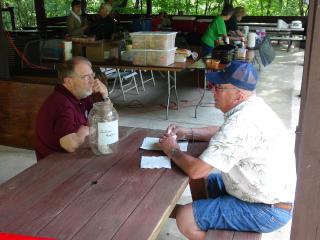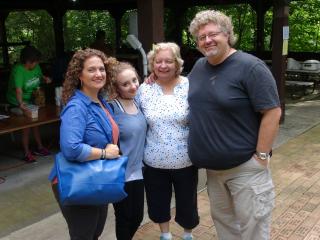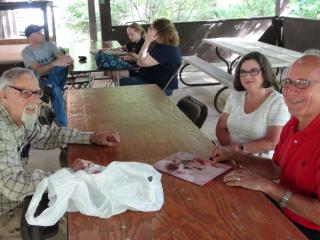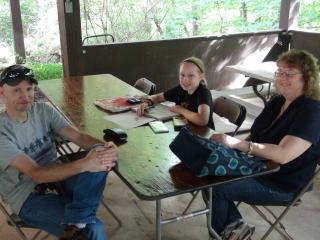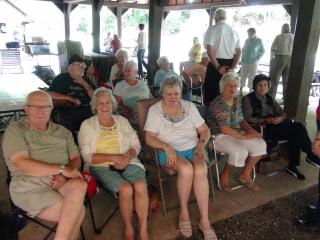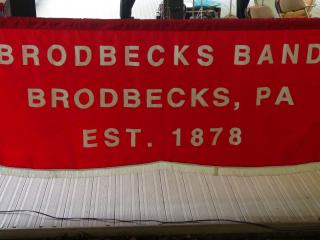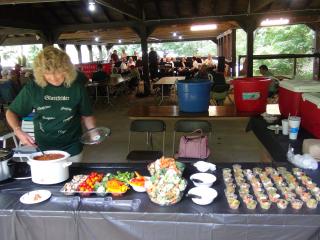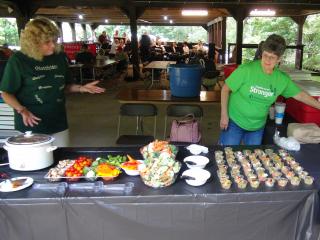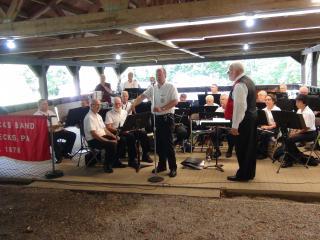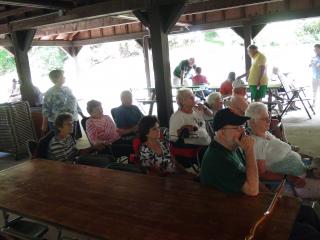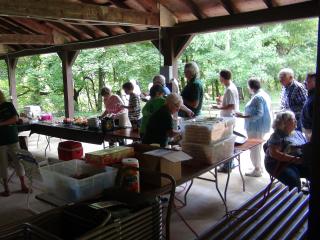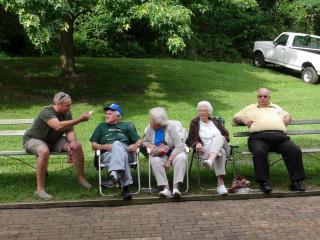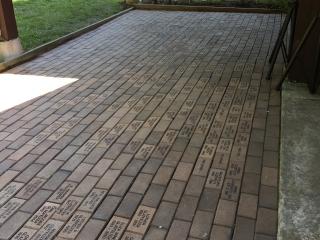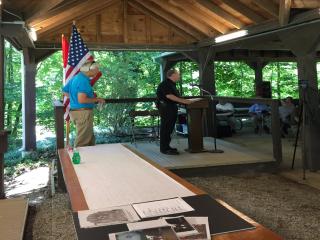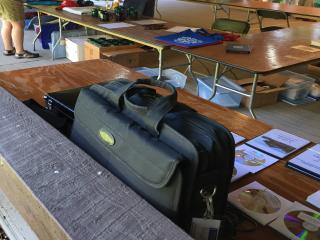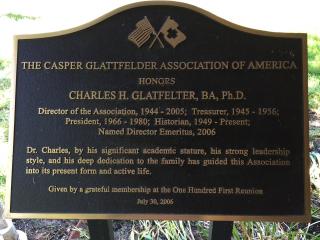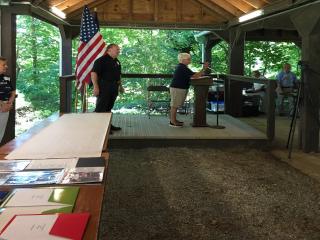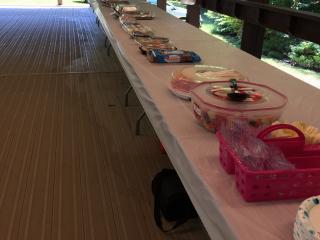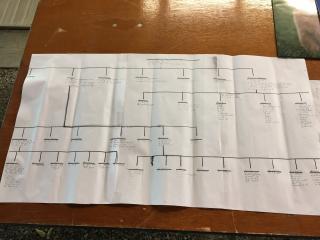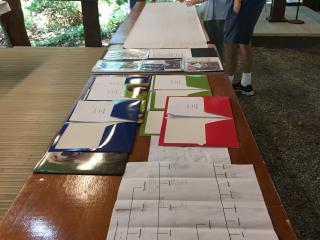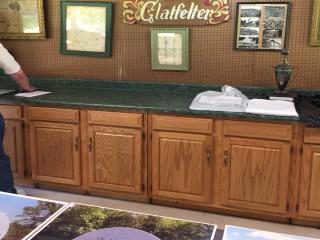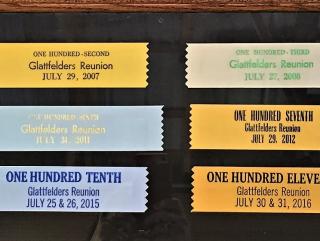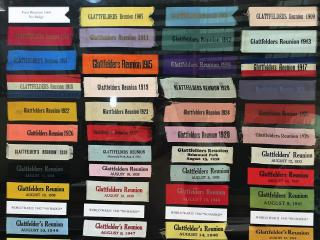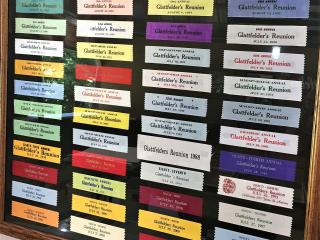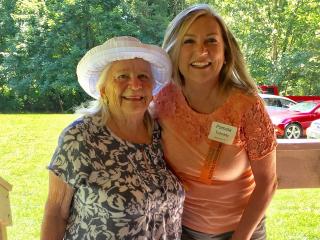Our 112th Reunion
July 29th and 30th, 2017
Reunion Theme: Honoring the family of Casper's brother John Peter
Fellow members of the Glattfelder family:
The 112th annual family reunion was held at Heimwald Park, Glatfelters, Pa., on Saturday July 29 (99 people attended) and Sunday July 30 (86 people attended).
John Peter and his descendants
Over the years, a frequent correspondent and reunion-goer has been Agnes Yount. Not long ago, she made a suggestion to the Association for a reunion theme: John Peter Glattfelder, brother of Casper, and his descendants. A wonderful idea, the Association board decided, and so it was.
Agnes and several other John Peter descendants attended the reunion this year. Here are excerpts of this year’s historical program:
Board member Philip Glatfelter began with some background:
“In 1742, a group of travelers left Glattfelden, Switzerland, on a long journey that would eventually lead them to America. Among them were two brothers and their families. One was our immigrant
ancestor, Casper Glattfelder. Another was his brother, John Peter.
“Our association was founded, based on the ancestry of the one brother. We will talk in much greater length about Casper next year, when we celebrate the 275th anniversary of his arrival in America. Today, we'll look at some of the ancestry of John Peter.
“We obviously know that Casper came to America. He and his troop landed in Philadelphia in August 1743 on the ship "Frances and Elizabeth," concluding a journey from Europe that probably lasted from seven to 12 months.
“We also know that John Peter was not among those who disembarked. … Records only indicate that he died before Aug. 30, 1743. One source said he likely died on the trip to America. In a letter to our association from Pastor Edwin Jaeggli of Glattfelden in 1901, he says that "John Peter died in April
1742 while on his way to embarking to America and that his body was returned to Glattfelden for burial."
“While John Peter did not come to America, members of his family did. He married Salomea Amberg in 1721. There is conflicting information on Salomea, but in one piece of information from our longtime historian Dr. Charles H. Glatfelter, he says that he ‘never found any evidence of Salomea in York County. ... She may well have died on the voyage, as others in the company did.’
“We find more conflicting information on the children. … The four children we do know about are Elizabeth, Anna Barbara, Felix and Hans Rudolf.
“We'll start with Elizabeth, who was born in 1723 and married Jacob Rein on Nov. 18, 1750. We have a contingent of Elizabeth's descendants here today. One of those, Dr. Robert Carpenter, will tell us more. Keeping things in chronological order, fellow Historical Committee member Jean Robinson will then give us a brief look at the line of Anna Barbara, who was born in 1725.”
Philip then introduced Dr. Carpenter, who was visiting with his wife from North Carolina. Here are excerpts of his talk:
As a descendant of Elizabeth Glattfelder Rhyne and on behalf of Ray and Agnes Yount, I bring you greetings from North Carolina.
… I would like to briefly discuss the commonalities and differences between our North Carolina German population with the Pennsylvania group while comparing the Glattfelder and Rhyne families. I understand that Glattfelder is Swiss. They originated in the village of Glattfelden, Switzerland, west of Zurich on the Glatt River.
… When the family came to Pennsylvania, they first settled along Conewago Creek in York County, but later settled in the Codorus area. There were also a number of Swiss Germans who migrated to North Carolina: my Zimmermans, Blancks, Manis, Eakers, Whisnants to name a few. These families were of the Reformed faith like the Glattfelders, but a few became Mennonite or Amish. My Zimmermans went that route. Religious affiliation was a factor in persons migrating from Switzerland. My Zimmermans left there in the 1690s-1710s going to Alsace. But as religious toleration dissipated, they traveled to America, settling first in Lancaster County, Pennsylvania, and later in North Carolina.
The Rhynes on the other hand were from the German states from a village named Blankenloch. The Rhynes came to America like your Glattfelders in a family and village group. Hans Martin Reinau, wife Magdalena Freymuller and family arrived in 1738.
… Hans Martin Reinau resided in York County and died here in 1750. Jacob Rein married Elizabeth Glattfelderr on Nov 18, 1750, and a few months later, secured a warrant for 50 acres near Codorus Creek.
As late as 1762, Jacob was taxed in Shrewsbury Township in York County, but by 1764, he was in North Carolina buying land from his sister-in-law’s brother, Philip Rudisill.
York County supplied quite a number of other families to North Carolina. For example, the various Rudisills … also settled in York County and later came to North Carolina. Elizabeth Rudisill … married in 1744 Hans Martin Reinau, the son of the senior by that name and brother to Jacob, who came to North Carolina. Unfortunately, he died in 1752, leaving a widow and seven children. Widow Elizabeth Rudisill Rein and her family settled in North Carolina by 1768, when she received a land grant, joining her parents and many of her brothers and sisters.
The York County/Christ Lutheran Church connection with North Carolina is strong. The French and Indian War raged during the middle 1750s. By 1757, Indian raids into North Carolina frontier
settlements caused deaths, many to leave and stopped migration to the area. By 1762, Colonial and British forces had destroyed the Indian threat by destroying their towns, food, and shelter.
At this time, the second great Migration West of the Catawba River occurred. A significant portion of that migration included members and neighbors to Christ Church in York. As already mentioned, Jacob Rein came by 1764, other members of the Rudisill family came following some of their relatives…
… Some might question the surnames: Rein was originally Reinau; Rein is spelled numerous ways with Rhyne being the most common usage currently. The same can be said for Glattfelder, with so many variations on the name. In North Carolina, it is often spelled Clodfelter. …
Jacob Rein wrote his will in 1793. His wife was a beneficiary, as was the Dutch Meeting House. ... By 1795, the will was probated, but we do not know when Elizabeth Glattfelder died. …
While Jacob did not name his children in his will, they have been determined through his estate papers and the estate papers of single daughter, Elizabeth. His descendants number into the thousands and reside throughout the country, originally moving to Tennessee, Missouri, Arkansas, Texas, Georgia and further west and south, always seeking the American Dream.
By the early 1800s, some Rhynes had acquired slaves, large land holdings and profitable businesses. One entrepreneur, Moses H. Rhyne, operated two stores, held interest in Woodlawn cotton mill, owned 12 slaves, owned a piano, 607 acres, a gold watch, a “pleasure vehicle” worth $75 and furniture worth $100.
His sons, Daniel Efird and A.P., also invested in cotton manufacturing after the Civil War. Daniel Efird Rhyne became fabulously wealthy, owning numerous cotton mills, investments in other businesses and donating significant funds to the Lutheran-supported Lenoir College in Hickory, N.C. His donation was so appreciated that the college was renamed Lenoir Rhyne College.
Religion was very important to the Rhyne family. The Dutch Meeting House, which received funds from Jacob Rein’s will, was a union church of Lutheran and Reformed, and at one time, of a Brethren (Dunkard) congregation. While no membership lists exist for this church in the 1700s, it is certainly possible that Elizabeth Glattfelder Rhyne attended Reformed services, or most likely, they both attended services, Reformed or Lutheran, depending upon which preacher was present.
Their son, Adam Cloninger, later deeded land to the church. Agnes and I have attempted to compile a
list of pastoral descendants and have quite a list with many certainly left out.
Politically, the Rhynes have been involved as they accumulated resources and following. They served in Congress, the state legislature, on town boards, on county commissions and school boards, as sheriff and as mayor.
Many Rhyne descendants have served our country in the military, from the Revolution to the Civil War, both World Wars, Korea and Vietnam, and recently with conflicts in the Middle East. Their
willingness to sacrifice for the country’s benefit has helped preserve our great nation.
Education has also been a consistent priority for Rhynes and their descendants. I served for 34 years in public education as a teacher and assistant principal, and the last 24 years as a principal. I retired and then taught at Belmont Abbey College, from which I have now retired to pursue my last vocation: babysitting! We will be babysitting our two grandchildren.
The donation of Daniel Efird Rhyne to Lenoir Rhyne College has been mentioned. … Helen Rhyne Marvin was a history professor at Gaston College and the first female state legislator from Gaston County. Dr. O. P. Rhyne taught German at the University of North Carolina and Clemson. … Countless Rhyne descendants have served as teachers, principals, teacher assistants, cafeteria workers and in various other educational tasks over the years.
Science has been another passion for Rhynes. Daniel Stowe started and financed Stowe Botanical Gardens near Belmont. James Rhyne Killian, a Duke grad, served as president of MIT and worked in official capacities in response to Sputnik and NASA. Four Lineberger descendants established the Lineberger Foundation, which completed the UNC Lineberger Comprehensive Cancer Center. And descendants have practiced all kinds of medicine: dentistry, optometry, medical doctor, etc.
With Rhyne descendants having educational, manufacturing, scientific, medical, religious and banking vocations, one central feature has remained: farming. While many early Rhynes possessed a German-learned trade and practiced their trade, most also farmed the land for subsistence and profit.
My uncle, Kenneth Friday, farmed vegetables -- tomatoes, cantaloupes, watermelons -- and raised eggs for sale. Starting in 1884, M.A. Rhyne operated one of the most successful dairies in the area east of the newly established town of Gastonia. It grew and thrived until urban expansion resulted in the family selling their farm.
Much has changed from the time Jacob Reinau and Elizabeth Glattfelder came with their families to Pennsylvania, got married and settled in North Carolina. Yet the industrious nature, keen intellect and moral fiber of descendants remain in our veins. I thank our ancestors for their sacrifices so that we
might enjoy our lives today.”
Jean then offered some of her research on Anna Barbara:
The second child of John Peter and Salomea was named Barbara, born circa 1725 in Zurich, traveling with her family to America. At that time, her age may have been about 16.
In America, while her brothers Rudolph and Felix and her sister Elizabeth had moved to North Carolina, Barbara remained here in York County and married John Hildebrand. Together, they would raise a family of 10 children living on farms in Shrewsbury and Springfield Townships. Barbara and John are reported to be buried at Bupp's Union Cemetery.
Most of their children marry in York County and introduce the names of Simon, Schwartz, Stiffler, Gardner, Cramer, Hartman and Shirey into the Glattfelder family tree, establishing their homes here for future generations.
If you are familiar with the websites of FamilyHart and FamilySearch.org, you are corresponding with Don and Jeanine Hartman. Don is a descendant of Barbara's daughter Anna Barbara, married to Ludwig Hartman. Our shared roots run deep.
Philip continued with information on Felix and Hans Rudolph:
Next in line is Felix. He was born in 1727 and, on Oct. 24, 1750, married Maria Sarah Meier. We see the last name spelled in other variations; we also have her simply as Sara Myers. They had seven children, born between 1751 and 1770.
Sometime in the 1760s, Felix and Sarah moved to North Carolina, where they lived the rest of their lives. Their tombstones are in Bethany Reformed graveyard, Davidson County. For the most part, their descendants use the spelling Clodfelter.
One descendant through Felix's son John (born 1751), James Ferguson Jr. of Huntsville, Ala., wrote in the book, “The Heritage of Rowan, County, N.C., Vol. I,” in 1991, of his line of descent. Both of his great grandmothers were descendants of John through John's grandsons Daniel and Lewis.
One set of James’ great grandparents, James Madison Ferguson and Eliza Ferguson, are buried in Bartholomew County, Ind., having migrated there in 1855 by wagon train from Winston-Salem, N.C. They followed Clodfelter relatives who had previously gone to Indiana from North Carolina.
Felix's son Jacob married Margaret Hagge on June 28, 1790. They also are buried in Bethany Cemetery. Among their 11 children was Joseph. In the publication “Folk Art in Stone,” a section titled
Pierced Style: Circa 1800-1850, it notes, “The finest collection of mature Swisegood school gravestones is at Abbott's Creek. Here, on the rear of the headstone of Josiah Spurgin, died 1802, is the only local stonecutter's signature in the county, which states: Maid by the hand of Joseph Clodfelter.”
(The Pierced Style, according to the publication, is “attributed to the Swisegood school of cabinetmakers, active from about 1800 to the mid-19th century. These exuberant Baroque gravestones
are without precedent in America, nor is similar tradition apparently known in Europe.”)
The 1813 and 1814 gravestones of Felix Gladfelter and his wife Sarah, the most significant monuments of the Pierced Style, may have been cut by their son Jacob.
Jacob's own tombstone is almost certainly Joseph's work, and is one of the finest examples of the mature Pierced Style. Jacob's and Margaret's gravestones “are almost identical and stand side by side in the Bethany churchyard.”
Philip then introduced Joe Myers, who was visiting from Arizona and had an interesting story to tell, relating to two of John Peter's children.
I am a direct descendent of Johann Peter, through his son Felix Glattfelder and Maria Sarah Myers (Joseph Clodfelter is their descendent). I am also a descendent of Christian Myers, the brother of Maria Sarah (Charity Myers was his descendent). The group all migrated to Rowan County together in 1764.
The “affair” was in 1832. DNA and the bastard bond records “prove” that Joseph Clodfelter was the un-named father. My Myers name came from Charity.
The confusion comes from my grandmother, Mary Ella Etter. A lot of family trees on Ancestry.com have her ancestor, Daniel Etter (born 1750 in Pennsylvania; he lived in the Lebanon-Lancaster region) married to Mary Magdalene Rein, or Rhyne, and if true, it would make me a direct descendent of Johann Peter a second time -- through the Etter line. But we know this is impossible because Mary Magdalene moved to North Carolina at age 13 and married Adam Cloninger.
My best guess is that Daniel Etter married Maria Margaretha Rein, the daughter of the sister of Jacob Rhyne, Susan Rein (she never married). The two girls (Maria Magdalena and Maria Margaretha) were born a month apart in 1751 and both baptized on the same day, Sept. 8, 1751 at Christ Lutheran Church in York. This discovery was just made a week ago, but makes perfect sense to me (admittedly speculation).
Philip finished the historical program with some information on Hans Rudolph:
The final son of John Peter who we'll talk about briefly is Hans Rudolph. He married Veronica Netzberger (or Hershberger) in Lancaster, though we're uncertain of the date. They had six children.
Rudolph appears on the 1782 and 1785 tax lists in Shenandoah County, Virginia. In 1787, he bought 190 acres of land, and in 1804 sold 200 acres to sons Jacob and John with the provision they not sell it in his lifetime. Rudolph does not appear in the 1810 census and presumably died before then.
In a piece written by Hans Rudolph descendant James J.S. Johnson, he tells about his lineage through Rudolph's oldest son George, who was born in 1768 in York and died in Catawba, North Carolina.
Included in that line is Fanny Clodfelter, James Abernethy and George Washington Abernethy, who moved to Texas in 1885.
…Our last Hans Rudolph descendant of note is … Kenneth Clodfelter. He was the son of John and Gloria Clodfelter of Mechanicsville, Va., who was killed in the terrorist bombing of the USS Cole in Yemen in 2000. Seventeen sailors died when a boat with explosives aboard rammed the destroyer.
John and Gloria nearly had a further burden to bear after the 9/11 terrorist attacks. Another son, Joe, was a U.S. Marine at the time. Fortunately, he called the next day from Quantico Marine Corps Base in Virginia to tell them he was OK.
To close our program today, I think it is good to look at a 1991 letter to Russ Clodfelter of Sterling, Colo., from Dr. Charles. He noted that at the time “we know much less here in Pennsylvania about the family of John Peter Glattfelder than we do about that of his younger brother, Casper. Perhaps this is natural since almost all of Peter's family left Pennsylvania and for a long time was effectively lost for us.
As you see from today's program, we have since learned a good bit more.
Dr. Charles wrote in a letter to Dr. Margaret H. Weiler of Bradford, N.H., mentioning our brick patio, “I continue to be amazed that there are 31 bricks for John Peter's line.” As of today, we have 37.
Back to Dr. Charles' letter to Russ Clodfelter, he wrote, “The interest in recent years has increased. From time to time, descendants of John Peter have attended our annual family reunions and we have tried to make them feel welcome.”
Obviously, the interest continues and we're glad John Peter's descendants attend our reunion, and we hope they feel more than welcome.


